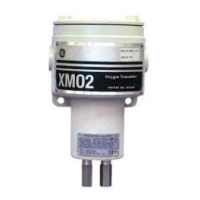September 2007
6-12 General Programming
PRESSURE CURVE Option The Pressure Curve option is used to enter pressure calibration data
for an XMO2 that has been supplied with an atmospheric pressure
sensor. To use the Pressure Curve option, refer to the menu map in
Figure C-3 on page C-3 and complete the following steps:
Note: The Gas Curve option appears only if Pressure Compensation
is
ON (Background Compensation may be either ON or OFF),
as specified in the System Mode menu (see page 6-4).
The # Points prompt lets you specify the number of data points that
comprise the pressure curve. Obtain this value from your Calibration
Sheet (see page 8-6 for a sample calibration sheet).
At the mmHg prompt, you can enter the pressure value for one of the
pressure curve data points listed on your Calibration Sheet (see page
8-6 for a sample calibration sheet).
Note: The pressure units displayed in the next prompt are specified
in the Select Pressure Type option of the Advanced Menu. The
choices are Pres (generic), mmHg (used as an example in this
manual), PSIa, and kPa. Refer to Chapter 7, Advanced
Programming, for more details.
The next prompt to appear depends on whether you selected Numeric
Entry or Introduce Gases at the Calibrate Mode prompt on page 6-5.
Proceed to the appropriate section on the next page to continue the
programming sequence.
CALIBRATE SYSTEM
Press [Y] or [Enter] to enter the
Pressure Curve submenu.
Pressure Curve?
Enter Pressure Curve
To accept the current value, press
[Y] or [Enter]. To change the
current value, use the numeric
keys to enter a new value and
press
[Y] or [Enter] twice.
# Points [n]:
Enter Pressure Curve
To accept the current value, press
[Y] or [Enter]. To change the
current value, use the numeric
keys to enter a new value and
press
[Y] or [Enter] twice.
mmHg [xxx.x]:

